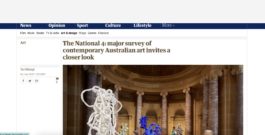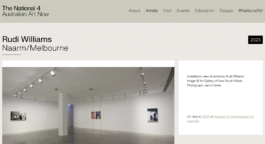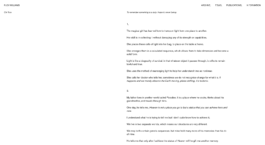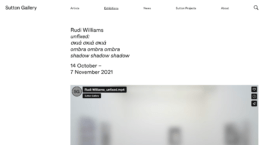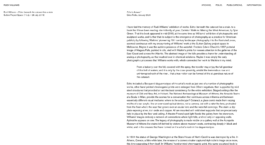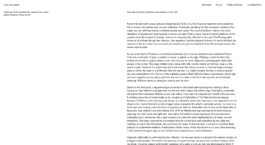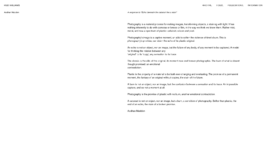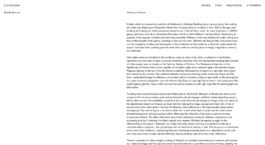Echo’s Answer*
Giles Fielke, January 2020
A response to: Echo: beneath the cataract lies a stain
Sutton Project Space (7 July – 28 July, 2018)
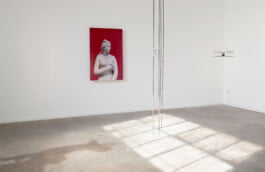
I have tied the memory of Rudi Williams’ exhibition of works, Echo: beneath the cataract lies a stain, to a book that I have been reading intermittently all year, Carleton Watkins: Making the West American, by Tyler Green. That this book appeared in mid-2018, at the same time as Williams’ exhibition of photographic and sculptural works, and further that its subject is the emergence of photography as a practice for American publicity by following Watkins’ pioneering 19th century landscape photography into the illustrated press, seemed continuous with my encountering of Williams’ work at the Sutton Gallery project space in Melbourne. Maybe it was the sublime presence of the waterfall: Frederic Edwin Church’s 1857 pictorial image of Niagara Falls, painted in oils, vied with Watkin’s prints for viewers attention in the galleries of the East Coast and across the Atlantic. The abstract image of the falls provides a frame for understanding all analogue photography, as that washed over in chemical solutions. Maybe it was simply the early photographic processes that Williams works with, which connected her work to Watkins in my mind.
From a balcony over the fall, covered with the spray, the traveller may enjoy the full grandeur
of this hell of waters; and it is only by the close proximity, amidst the tremendous roar and
uninterrupted rush of the river... that a true notion can be formed of the stupendous nature of
the cataract.
Echo: beneath the cataract lies a stain included a Becquerel daguerreotype of the artist’s neck as just one of a number of photographic works, other hand printed chromogenic prints were enlarged from 35mm negatives, then supported by mild steel structures that provided an architectural consistency for the entire exhibition. Staged settings like the museum of Old and New Art, in Hobart; The National Archaeological Museum of Athens; the Ansaldo Teatro alla Scala in Milan, provide the scenes for a conversation that continues across millennia and between essentially different visual mediums: where is the archetype? Cataract, a glass comb made from varying widths of clear acrylic, like an over-sized optical device, not a camera, but with a rake-like lens, protruded from the floor where the scar that grows over an ocular lens and the waterfall converge. The stain: a dry-plate exposing silver, iron oxide and copper. All are mounted with mild steel supports that are precariously held in place by the floor and ceiling. A theatre Fresnel spot light floods the gallery from the storeroom. Williams’ images embody a network of connections where light falls, and not only on opposing walls. Aphrodite appears on one. The legacy of photography is made visible on a gallery wall at the Acropolis Museum of Athens like stains left behind by visitors above museum seats, contrasting deeply in black and white; and in the creases that have formed on the artist’s neck in the daguerreotype.
In 1831 the statue of George Washington at the State House of North Carolina was destroyed by a fire. In Athens, Greece, a little while later, the release of a camera shutter captured Aphrodite’s image once more, this time separating it from itself. In Williams’ hand-printed chromogenic print, this same sculptural body is reproduced in deep vermilion and washed from the foamy emulsion in which it appeared. Curiously, the two figures, Washington and the Venus, share a trace that cuts across their otherwise disparate histories. One a neo-classical statesman, the other an antique bridal veil, they have come to represent two poles of our patriarchal hegemony. The statue of Washington shows the American in Roman Republican garb. It has recently been re-fabricated from a maquette, and now resides in the galleries of the Frick collection, New York. When Washington died in 1799 Niagara Falls was yet to be found by the Europeans. Washington would never realise America as a landscape, despite winning its independence from Great Britain. Meanwhile the sculpture of Aphrodite was returned to Greece via England, after its basis on an earlier original now in the Museo Nazionale in Syracuse, Sicily. Two-hundred years since it’s production, Washington’s likeness and Williams’ photograph of Aphrodite can be linked by the marks they share, on their breasts, and from the figurative trace of their encounter with the studio of Antonio Canova, the Northern Italian sculptor who figures here as the bridge between the neo-classical impulse of modern art and the contemporary wish for antiquity.
Canova’s Washington was made for America, his Aphrodite restored for Europe. Now, everything must be re-made: today Washington would not recognise his America, and there is no European Union which contains Great Britain. Williams’ collection presents fragments from the dream of the reconciliation of the old world with the new. Here America, often idealised as a continental Venus, is the model for photography: territorial conquest precipitates a war of representation. The same is true for Australia. Williams’ work shows how photography is stained by history.
Not long after Washington’s marble immolation, the American transcendentalist Ralph Waldo Emerson published a book-length essay titled Nature. In describing it, Oliver Wendell Holmes, a fireside poet and a part of Emerson’ extended milieu, wrote the following: “There are sentences in Nature, which are as exalted as the language of one who is just coming to himself after having been etherized.” What then, Holmes argues, is nature but the etherised conscious that remembers from where it has come? This image seems to oppose another by Emerson: the wandering cyclops, gazing across and making visible the land colonised two centuries before by British settlers (and now symbolised by the mythologised disappearance of the American Venus, Virginia Dare, who was the first English settler born in what is now the United States of America). What work Williams figures is the territorialising impulse of photography, yet in the suspended zone of the museum the image remains distinct. The works depicting the inside of a museum or gallery reveal its staged and theatrical nature.
Holmes’ formula proposes blindness, however, a withdrawal of sensibility as the condition for exaltation. Transcendence meant nature, and to leave this body for the earthly delights of sleep was to dwell on the other side of history, to escape the burden of consciousness. This was Watkins’ challenge: to awaken the American conscious from its dream of nature, through his captured depictions of key landscape-monuments like Yosemite, in which they were yet too afraid to sleep. Watkins’ images were hung in Lincoln’s White House during the Civil War. If it is fair to enforce a connection between Watkins and Williams, I wonder what, then, is Williams’ destiny as a photographer documenting the past today? It is, I think, nothing less than the unconscious intrication of the present, one in which we find ourselves reflected, eclipsed, and drawn to the realisation of our own bodies in the landscape—simultaneously asleep and awake, we are the echo that recalls an event now lost to irredeemable time.
Holmes authored a long, early essay on photography in 1859 titled “The Stereoscope and the Stereograph”. The possibility of truth in photography, he realised from its outset, lies in the negative image that embodies the reciprocal deceit of the stained surface: was it Canova who restored Aphrodite? Or was it the sculptural restoration studio of Carlo Albacini, with whom Canova visited while in Rome? Or was it in Naples? In any case it was only her nose and left arm. What about Washington? What caused the fire? It is important that Holmes’ thinking through photography first appeared in The Atlantic, which had been recently established in
Boston, it is all the more appropriate because its figure was a massive body of water:
If a man had handed a metallic speculum to Democritus of Abdera, and told him to look at his
face in it while his heart was beating thirty or forty times, promising that one of the films his
face was shedding should stick there, so that neither he, nor it, nor anybody should forget what
manner of man he was, the Laughing Philosopher would probably have vindicated his claim to
his title by an explosion that would have astonished the speaker.
This is just what the Daguerreotype has done. It has fixed the most fleeting of our illusions, that
which the apostle and the philosopher and the poet have alike used as the type of instability
and unreality. The photograph has completed the triumph, by making a sheet of paper reflect
images like a mirror and hold them as a picture.
Williams’ presentation of the daguerreotype returns us to the origin of photography. A process that relied on iodine vapours and bromine to sensitise the polished silver-plated surface of the photographic plate, realising a completed image as an object. For ease of reproduction, this process was divided in the wet plate collodion process preferred by en plein-air photographers like Watkins, into a negative from which a positive print can be made. In this sense it participates in the renegotiation of the ancient idea of figures, somewhat incredibly described as films by the pre-Socratic philosophers. The origins of photography are, like all arché, incredibly hard—impossible—to disentangle from the contingencies of the past. Williams’ work, a “failed” daguerreotype titled Stain, even prefigures the photographic image by mirroring and reproducing the patch of discoloured marble visible on the breast of the restored Aphrodite. One material used early in the development of the collodion process is commonly called Bitumen of Judea, a naturally occurring asphalt that is sensitive to light that has been used for thousands of years as pitch, that is, petroleum. Herodotus claimed it was used as mortar in the walls of Babylon.
In the early part of the 19th century Nicéphore Niépce, who also invented the world’s first internal combustion engine, conceived of fixing the “light paintings” of the camera obscura by conflating them with lithography, which relies on the repulsion of oil and water. From the particular intensity of the mid-19th century, Holmes describes the daguerreotype process— amongst others more conventional and contemporary—far better than I can from the 21st:
THE DAGUERREOTYPE—A silver-plated sheet of copper is resilvered by electro-plating, and
perfectly polished. It is then exposed in a glass box to the vapor of iodine until its surface turns
to a golden yellow. Then it is exposed in another box to the fumes of the bromide of lime until it
becomes of a blood-red tint. Then it is exposed once more, for a few seconds, to the vapor of
iodine. The plate is now sensitive to light, and is of course kept from it, until, having been
placed in the darkened camera, the screen is withdrawn and the camera-picture falls upon it. In
strong light, and with the best instruments, three seconds' exposure is enough,—but the time
varies with circumstances. The plate is now withdrawn and exposed to the vapor of mercury at
212 degrees. Where the daylight was strongest, the sensitive coating of the plate has
undergone such a chemical change, that the mercury penetrates readily to the silver,
producing a minute white granular deposit upon it, like a very thin fall of snow, drifted by the
wind. The strong lights are little heaps of these granules, the middle lights thinner sheets of
them; the shades are formed by the dark silver itself thinly sprinkled only, as the earth shows
with a few scattered snow-flakes on its surface. The precise chemical nature of these granules
we care less for than their palpable presence, which may be perfectly made out by a
microscope magnifying fifty diameters or even less.
The picture thus formed would soon fade under the action of light, in consequence of further
changes in the chemical elements of the film of which it consists. Some of these elements are
therefore removed by washing it with a solution of hyposulphite of soda, after which it is rinsed
with pure water. It is now permanent in the light, but a touch wipes off the picture as it does the
bloom from a plum. To fix it, a solution of hyposulphite of soda containing chloride of gold is
poured on the plate while this is held over a spirit-lamp. It is then again rinsed with pure water,
and is ready for its frame.
Williams’ exhibition made the form of these processes evident by sublimating the stain on Venus’ breast. The stain is revealed as the formless ground for the artwork. If the development of the image is viscous like water, the immaterial emerges from its base material and is dis-identified. “Form is hencefoth divorced from matter”, Holmes predicted this for understanding the world after the arrival of photography. Yet matter is now mixed with forms it is not. Williams’ photograph of the polystyrene Adam and column props at the Teatro La Scala workshop appear in this redistribution, reproducing a signature for our time.
Hope’s Deepdene Venus Minturnae
And the hollowed eyes of Antinous stare
Into every direction internally
They love all power
Anarchy drunk on the embodiment
Of antique youth perfected
Now petrified.
The waterfall that
Capsizes the bare skin of
A polychrome amulet
It’s frottage
And they wash the chemicals
With the bare-boned hands
Of a matriarch
A boomerang is, as
Answers Echo’s answer
Like an Onassis
A secular siren
That will sink these vessels
With the stare
Of the voice
The first model for the gaze
Is the stain, the index of
The absent wound gives
Canova’s registration of Aphrodite
A fixed feminine
Sensitivity and
Develops like the viscous liquid of
An occluded eye
The stain is the first model for the gaze, for Jacques Lacan it left his mark. The index of an absent wound, as Georges Didi-Huberman has made clear, is a model for the image. These thoughts are photographic—that is, they exist within cinematic time. A shadow is a shadow, like a clock that tells only one time. Nostalgia is impossible without a concept of the home. Origins are at best misleading and at worst, delusional. Echo is the reduction to voice as the sole signifier of the subject, but Narcissus—like Antinous—is trapped in a pharmacological haze produced by the figure of the self. “This paper is now sensitive; it has a conscience, and is afraid of daylight.” Holmes was right, the still lake has been re-composed as a technological pool: the silver halide of the film emulsion has a form of life all of its own. Like the network of presences felt between the works in Williams’ exhibition Echo: Beneath the cataract lies a stain, at the Sutton Gallery project space, the space between photography and reality must be kept open by history.
In 1958 the true colour of Aphrodite’s hair was the cause of an irresolvable dispute between Ezra Pound and Hollis Frampton. Then a 21 year-old heir-apparent to the kind of interior America established by Holmes and Emerson, the letters Frampton writes to his friends are electrified by the kind of objectifying desire that leads to a peculiar form of identification. There is the question: How to formalise the body? Photography was founded on this (and other) ideas about representation, right down to the chemical molecules selected to best service the technology for ideal ends. Canova represents the last generation of sculptor to work before the arrival of photography. Confounded by this problem, on the 21st of October 1962 Carl Andre, Frampton’s high-school friend, replied to Frampton’s inquiry: “you can carve, but not photograph the gods.”
*this essay was also inspired by the music and lyrics of Trish Keenan.



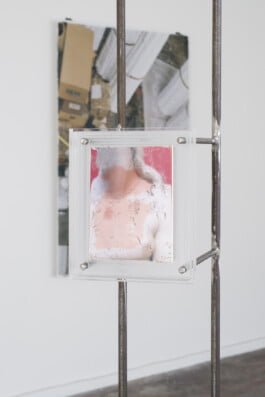
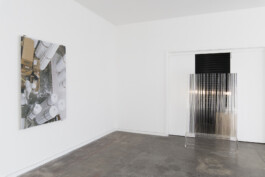

Echo’s Answer*
Giles Fielke, January 2020
A response to: Echo: beneath the cataract lies a stain
Sutton Project Space (7 July – 28 July, 2018)

I have tied the memory of Rudi Williams’ exhibition of works, Echo: beneath the cataract lies a stain, to a book that I have been reading intermittently all year, Carleton Watkins: Making the West American, by Tyler Green. That this book appeared in mid-2018, at the same time as Williams’ exhibition of photographic and sculptural works, and further that its subject is the emergence of photography as a practice for American publicity by following Watkins’ pioneering 19th century landscape photography into the illustrated press, seemed continuous with my encountering of Williams’ work at the Sutton Gallery project space in Melbourne. Maybe it was the sublime presence of the waterfall: Frederic Edwin Church’s 1857 pictorial image of Niagara Falls, painted in oils, vied with Watkin’s prints for viewers attention in the galleries of the East Coast and across the Atlantic. The abstract image of the falls provides a frame for understanding all analogue photography, as that washed over in chemical solutions. Maybe it was simply the early photographic processes that Williams works with, which connected her work to Watkins in my mind.
From a balcony over the fall, covered with the spray, the traveller may enjoy the full grandeur
of this hell of waters; and it is only by the close proximity, amidst the tremendous roar and
uninterrupted rush of the river... that a true notion can be formed of the stupendous nature of
the cataract.
Echo: beneath the cataract lies a stain included a Becquerel daguerreotype of the artist’s neck as just one of a number of photographic works, other hand printed chromogenic prints were enlarged from 35mm negatives, then supported by mild steel structures that provided an architectural consistency for the entire exhibition. Staged settings like the museum of Old and New Art, in Hobart; The National Archaeological Museum of Athens; the Ansaldo Teatro alla Scala in Milan, provide the scenes for a conversation that continues across millennia and between essentially different visual mediums: where is the archetype? Cataract, a glass comb made from varying widths of clear acrylic, like an over-sized optical device, not a camera, but with a rake-like lens, protruded from the floor where the scar that grows over an ocular lens and the waterfall converge. The stain: a dry-plate exposing silver, iron oxide and copper. All are mounted with mild steel supports that are precariously held in place by the floor and ceiling. A theatre Fresnel spot light floods the gallery from the storeroom. Williams’ images embody a network of connections where light falls, and not only on opposing walls. Aphrodite appears on one. The legacy of photography is made visible on a gallery wall at the Acropolis Museum of Athens like stains left behind by visitors above museum seats, contrasting deeply in black and white; and in the creases that have formed on the artist’s neck in the daguerreotype.
In 1831 the statue of George Washington at the State House of North Carolina was destroyed by a fire. In Athens, Greece, a little while later, the release of a camera shutter captured Aphrodite’s image once more, this time separating it from itself. In Williams’ hand-printed chromogenic print, this same sculptural body is reproduced in deep vermilion and washed from the foamy emulsion in which it appeared. Curiously, the two figures, Washington and the Venus, share a trace that cuts across their otherwise disparate histories. One a neo-classical statesman, the other an antique bridal veil, they have come to represent two poles of our patriarchal hegemony. The statue of Washington shows the American in Roman Republican garb. It has recently been re-fabricated from a maquette, and now resides in the galleries of the Frick collection, New York. When Washington died in 1799 Niagara Falls was yet to be found by the Europeans. Washington would never realise America as a landscape, despite winning its independence from Great Britain. Meanwhile the sculpture of Aphrodite was returned to Greece via England, after its basis on an earlier original now in the Museo Nazionale in Syracuse, Sicily. Two-hundred years since it’s production, Washington’s likeness and Williams’ photograph of Aphrodite can be linked by the marks they share, on their breasts, and from the figurative trace of their encounter with the studio of Antonio Canova, the Northern Italian sculptor who figures here as the bridge between the neo-classical impulse of modern art and the contemporary wish for antiquity.
Canova’s Washington was made for America, his Aphrodite restored for Europe. Now, everything must be re-made: today Washington would not recognise his America, and there is no European Union which contains Great Britain. Williams’ collection presents fragments from the dream of the reconciliation of the old world with the new. Here America, often idealised as a continental Venus, is the model for photography: territorial conquest precipitates a war of representation. The same is true for Australia. Williams’ work shows how photography is stained by history.
Not long after Washington’s marble immolation, the American transcendentalist Ralph Waldo Emerson published a book-length essay titled Nature. In describing it, Oliver Wendell Holmes, a fireside poet and a part of Emerson’ extended milieu, wrote the following: “There are sentences in Nature, which are as exalted as the language of one who is just coming to himself after having been etherized.” What then, Holmes argues, is nature but the etherised conscious that remembers from where it has come? This image seems to oppose another by Emerson: the wandering cyclops, gazing across and making visible the land colonised two centuries before by British settlers (and now symbolised by the mythologised disappearance of the American Venus, Virginia Dare, who was the first English settler born in what is now the United States of America). What work Williams figures is the territorialising impulse of photography, yet in the suspended zone of the museum the image remains distinct. The works depicting the inside of a museum or gallery reveal its staged and theatrical nature.
Holmes’ formula proposes blindness, however, a withdrawal of sensibility as the condition for exaltation. Transcendence meant nature, and to leave this body for the earthly delights of sleep was to dwell on the other side of history, to escape the burden of consciousness. This was Watkins’ challenge: to awaken the American conscious from its dream of nature, through his captured depictions of key landscape-monuments like Yosemite, in which they were yet too afraid to sleep. Watkins’ images were hung in Lincoln’s White House during the Civil War. If it is fair to enforce a connection between Watkins and Williams, I wonder what, then, is Williams’ destiny as a photographer documenting the past today? It is, I think, nothing less than the unconscious intrication of the present, one in which we find ourselves reflected, eclipsed, and drawn to the realisation of our own bodies in the landscape—simultaneously asleep and awake, we are the echo that recalls an event now lost to irredeemable time.
Holmes authored a long, early essay on photography in 1859 titled “The Stereoscope and the Stereograph”. The possibility of truth in photography, he realised from its outset, lies in the negative image that embodies the reciprocal deceit of the stained surface: was it Canova who restored Aphrodite? Or was it the sculptural restoration studio of Carlo Albacini, with whom Canova visited while in Rome? Or was it in Naples? In any case it was only her nose and left arm. What about Washington? What caused the fire? It is important that Holmes’ thinking through photography first appeared in The Atlantic, which had been recently established in
Boston, it is all the more appropriate because its figure was a massive body of water:
If a man had handed a metallic speculum to Democritus of Abdera, and told him to look at his
face in it while his heart was beating thirty or forty times, promising that one of the films his
face was shedding should stick there, so that neither he, nor it, nor anybody should forget what
manner of man he was, the Laughing Philosopher would probably have vindicated his claim to
his title by an explosion that would have astonished the speaker.
This is just what the Daguerreotype has done. It has fixed the most fleeting of our illusions, that
which the apostle and the philosopher and the poet have alike used as the type of instability
and unreality. The photograph has completed the triumph, by making a sheet of paper reflect
images like a mirror and hold them as a picture.
Williams’ presentation of the daguerreotype returns us to the origin of photography. A process that relied on iodine vapours and bromine to sensitise the polished silver-plated surface of the photographic plate, realising a completed image as an object. For ease of reproduction, this process was divided in the wet plate collodion process preferred by en plein-air photographers like Watkins, into a negative from which a positive print can be made. In this sense it participates in the renegotiation of the ancient idea of figures, somewhat incredibly described as films by the pre-Socratic philosophers. The origins of photography are, like all arché, incredibly hard—impossible—to disentangle from the contingencies of the past. Williams’ work, a “failed” daguerreotype titled Stain, even prefigures the photographic image by mirroring and reproducing the patch of discoloured marble visible on the breast of the restored Aphrodite. One material used early in the development of the collodion process is commonly called Bitumen of Judea, a naturally occurring asphalt that is sensitive to light that has been used for thousands of years as pitch, that is, petroleum. Herodotus claimed it was used as mortar in the walls of Babylon.
In the early part of the 19th century Nicéphore Niépce, who also invented the world’s first internal combustion engine, conceived of fixing the “light paintings” of the camera obscura by conflating them with lithography, which relies on the repulsion of oil and water. From the particular intensity of the mid-19th century, Holmes describes the daguerreotype process— amongst others more conventional and contemporary—far better than I can from the 21st:
THE DAGUERREOTYPE—A silver-plated sheet of copper is resilvered by electro-plating, and
perfectly polished. It is then exposed in a glass box to the vapor of iodine until its surface turns
to a golden yellow. Then it is exposed in another box to the fumes of the bromide of lime until it
becomes of a blood-red tint. Then it is exposed once more, for a few seconds, to the vapor of
iodine. The plate is now sensitive to light, and is of course kept from it, until, having been
placed in the darkened camera, the screen is withdrawn and the camera-picture falls upon it. In
strong light, and with the best instruments, three seconds' exposure is enough,—but the time
varies with circumstances. The plate is now withdrawn and exposed to the vapor of mercury at
212 degrees. Where the daylight was strongest, the sensitive coating of the plate has
undergone such a chemical change, that the mercury penetrates readily to the silver,
producing a minute white granular deposit upon it, like a very thin fall of snow, drifted by the
wind. The strong lights are little heaps of these granules, the middle lights thinner sheets of
them; the shades are formed by the dark silver itself thinly sprinkled only, as the earth shows
with a few scattered snow-flakes on its surface. The precise chemical nature of these granules
we care less for than their palpable presence, which may be perfectly made out by a
microscope magnifying fifty diameters or even less.
The picture thus formed would soon fade under the action of light, in consequence of further
changes in the chemical elements of the film of which it consists. Some of these elements are
therefore removed by washing it with a solution of hyposulphite of soda, after which it is rinsed
with pure water. It is now permanent in the light, but a touch wipes off the picture as it does the
bloom from a plum. To fix it, a solution of hyposulphite of soda containing chloride of gold is
poured on the plate while this is held over a spirit-lamp. It is then again rinsed with pure water,
and is ready for its frame.
Williams’ exhibition made the form of these processes evident by sublimating the stain on Venus’ breast. The stain is revealed as the formless ground for the artwork. If the development of the image is viscous like water, the immaterial emerges from its base material and is dis-identified. “Form is hencefoth divorced from matter”, Holmes predicted this for understanding the world after the arrival of photography. Yet matter is now mixed with forms it is not. Williams’ photograph of the polystyrene Adam and column props at the Teatro La Scala workshop appear in this redistribution, reproducing a signature for our time.
Hope’s Deepdene Venus Minturnae
And the hollowed eyes of Antinous stare
Into every direction internally
They love all power
Anarchy drunk on the embodiment
Of antique youth perfected
Now petrified.
The waterfall that
Capsizes the bare skin of
A polychrome amulet
It’s frottage
And they wash the chemicals
With the bare-boned hands
Of a matriarch
A boomerang is, as
Answers Echo’s answer
Like an Onassis
A secular siren
That will sink these vessels
With the stare
Of the voice
The first model for the gaze
Is the stain, the index of
The absent wound gives
Canova’s registration of Aphrodite
A fixed feminine
Sensitivity and
Develops like the viscous liquid of
An occluded eye
The stain is the first model for the gaze, for Jacques Lacan it left his mark. The index of an absent wound, as Georges Didi-Huberman has made clear, is a model for the image. These thoughts are photographic—that is, they exist within cinematic time. A shadow is a shadow, like a clock that tells only one time. Nostalgia is impossible without a concept of the home. Origins are at best misleading and at worst, delusional. Echo is the reduction to voice as the sole signifier of the subject, but Narcissus—like Antinous—is trapped in a pharmacological haze produced by the figure of the self. “This paper is now sensitive; it has a conscience, and is afraid of daylight.” Holmes was right, the still lake has been re-composed as a technological pool: the silver halide of the film emulsion has a form of life all of its own. Like the network of presences felt between the works in Williams’ exhibition Echo: Beneath the cataract lies a stain, at the Sutton Gallery project space, the space between photography and reality must be kept open by history.
In 1958 the true colour of Aphrodite’s hair was the cause of an irresolvable dispute between Ezra Pound and Hollis Frampton. Then a 21 year-old heir-apparent to the kind of interior America established by Holmes and Emerson, the letters Frampton writes to his friends are electrified by the kind of objectifying desire that leads to a peculiar form of identification. There is the question: How to formalise the body? Photography was founded on this (and other) ideas about representation, right down to the chemical molecules selected to best service the technology for ideal ends. Canova represents the last generation of sculptor to work before the arrival of photography. Confounded by this problem, on the 21st of October 1962 Carl Andre, Frampton’s high-school friend, replied to Frampton’s inquiry: “you can carve, but not photograph the gods.”
*this essay was also inspired by the music and lyrics of Trish Keenan.






